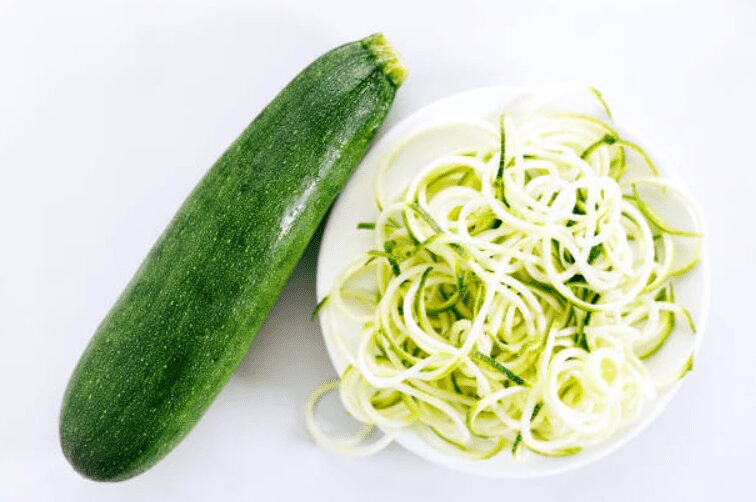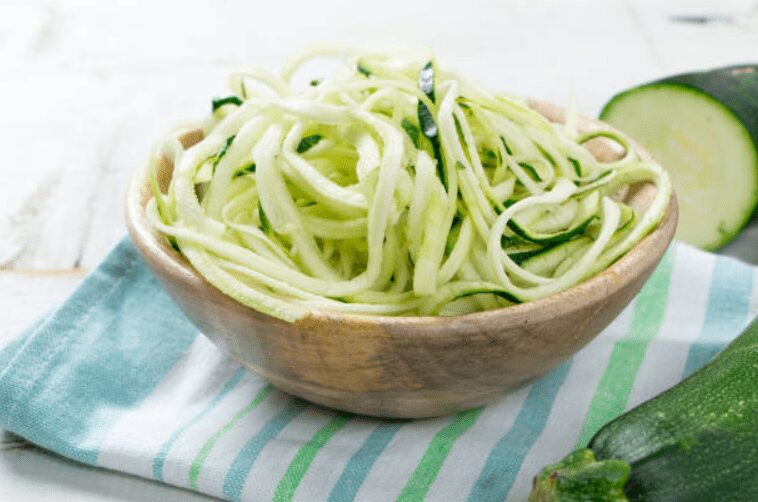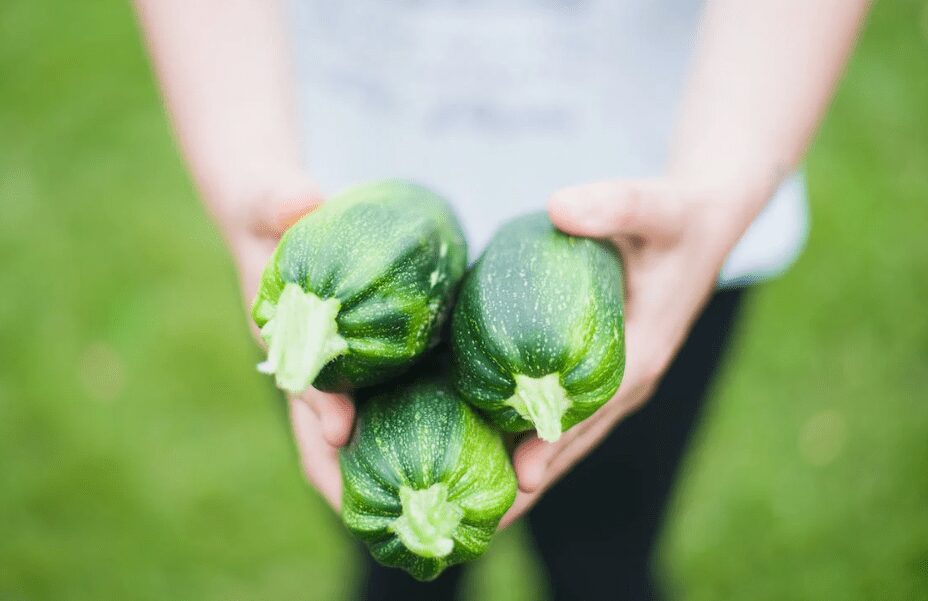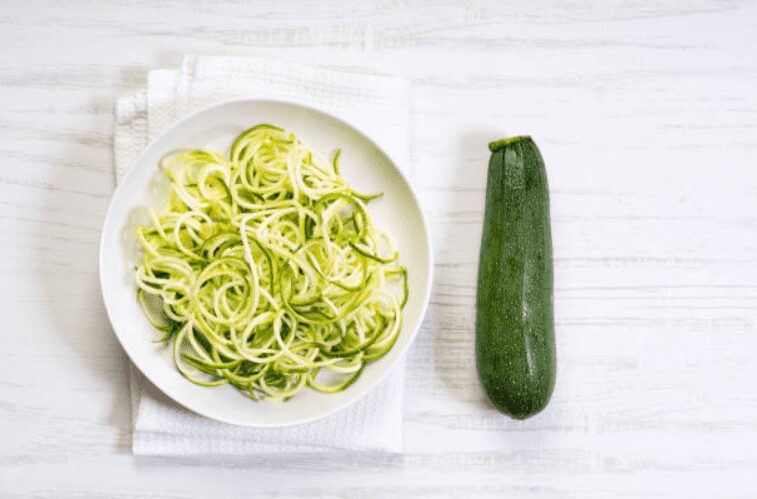Zucchini noodles, or zoodles, are a great way to enjoy a healthy and low-calorie alternative to wheat noodles or spaghetti. Zoodles can be made into different shapes using a spiralizer, julienne, sharp peeler, or mandoline.
They are also an excellent option for those following a gluten-free or low-carb diet as they are low in carbs and high in flavor and nutrients.
Freezing spiralized zucchini in portion sizes is an easy way to always have a quick, nutritious meal on hand. In this post, we’ll share with you some tips on how to freeze zucchini noodles.
Steps For Making Zucchini Noodles

The most popular way to make zucchini noodles is with a spiralizer, which is a kitchen tool that quickly and easily turns vegetables into long, thin strands.
To use a spiralizer, simply attach the vegetable to the end of the tool and twist it around until you have created your desired shape.
This method is quick and easy, but there are other methods for making zucchini noodles as well.
For those who don’t have a spiralizer, you can still make zucchini noodles with a simple vegetable peeler or even a sharp knife. With either of these tools, you can create thin strips of zucchini that resemble spaghetti-like noodles.
To do this, start by peeling off thin strips from the sides of the zucchini until you reach the center core. Then cut each strip into thinner pieces to create your desired noodle shape.
Once you have finished cutting your noodles, cook them in boiling water for about two minutes before serving them with your favorite sauce or topping.
How To Freeze Zucchini Noodles
Zucchini noodles or zoodles can be found in the vegetable aisle of most supermarkets, but if you’re feeling adventurous you can make your own at home.
To ensure that your zucchini noodles remain firm to the touch and retain their original flavor when freezing them, there are some important steps to follow.
First, it is important to blanch the zucchini noodles before freezing them. This involves boiling the noodles for about 1 minute and then immediately transferring them into an ice bath. This helps stop the cooking process and prevents them from becoming soggy when frozen.
Once blanched, drain the noodles well and spread them out on a baking sheet lined with parchment paper or wax paper. Place the baking sheet in the freezer for about an hour until they are completely frozen.
Finally, transfer the frozen zucchini noodles into airtight containers or freezer bags for storage. Following these steps will help keep your zoodles fresh and flavorful for up to three months.
Freezing Raw Zucchini Noodles

Make a regular batch of zucchini noodles first. After that, put them in an airtight container or zip-top freezer bag. Ensure that you immediately freeze them.
When you are prepared to serve, place the frozen zoodles on your kitchen counter to thaw. There might seem to be more liquid present than usual.
This extra water must be removed because it is unnecessary. Once the zucchini noodles defrost, make sure to pour the liquid off.
Cook your zucchini noodles according to the recipe after they have defrosted and been drained.
Storing Cooked Zucchini In The Refrigerator
Storing cooked zucchini noodles in the refrigerator is a great way to keep them fresh and delicious for later use. Depending on how you initially cooked your zucchini noodles, the storage method and materials will vary.
If you blanched or sautéed your zucchini noodles, it’s best to line a plastic or glass container with paper towels before placing the noodles inside.
This will help absorb any excess moisture that may have been created during cooking. It’s also recommended to use a double layer of paper towels for added protection against spoilage.
You can also store cooked zucchini noodles in resealable freezer bags or plasticware containers, as long as they are lined with paper towels first.
Do We Need To Blanch Zucchini Noodles Before Freezing?
Blanching zucchini noodles before freezing can be a great way to extend their storage life. Blanching involves a quick dunk in boiling water, followed by drying off any excess water on a paper towel.
This helps to deactivate enzymes that can cause the noodles to spoil quickly. For short-term freezing, blanching is not necessary, but for longer-term storage, it is recommended.
How Long Do You Blanch?

Blanching is a cooking technique used to soften vegetables and fruits. It involves briefly submerging the food in boiling water, then immediately transfer it to an ice bath.
This process helps to preserve the color, texture, and flavor of the food while also making it easier to digest. Blanching zucchini is the best way to prepare it for further cooking or freezing.
The length of time you blanch zucchini depends on how thickly it has been cut. For thin zucchini noodles, just a few seconds in boiling water is enough to soften them up.
If you’re blanching cubes of zucchini, however, you may need a few minutes in the boiling water before transferring them to an ice bath. Blanching can be a good way to quickly cook your vegetables without losing any of their nutritional value or flavor.
Are Frozen Zucchini Noodles Good?
Zucchini is an incredibly versatile vegetable, and when frozen it can be used in many different dishes. The texture of the zucchini may be slightly altered due to the freezing process, but this does not take away from the flavor of the dish. Frozen zucchini noodles are easy to prepare, as all you need to do is thaw them out before cooking.
Frozen zucchini noodles are a good option for those looking for a healthier alternative to traditional pasta dishes. They can be used in stir-fries, soups, salads, and more.
You can also mix them with other vegetables or proteins for a delicious meal that is both nutritious and satisfying. If you’re looking for something new and exciting to try in your kitchen, give frozen zucchini noodles a try.
How Long Do Zucchini Noodles Last In The Freezer?
The answer is that frozen zucchini noodles can last up to a year in the freezer. However, it is important to note that their flavor and texture will start to deteriorate over time.
Therefore, it is best not to wait too long before consuming them. If you plan on freezing your zucchini noodles, try to use them within a week for optimal taste and texture.
Additionally, make sure that your zucchini noodles are properly sealed before freezing them so that they don’t become freezer burned or contaminated with other foods. With proper storage and handling, you can enjoy delicious zucchini dishes all year round.
Ways To Prevent Watery Zucchini Noodles

Methods For Stovetop
- After spiralizing the zucchini, pat the noodles dry with paper towels. In fact, regardless of how you plan to prepare them later, this is a fantastic idea as a starting point.
- When cooking, do not cover the zucchini, and cook zucchini noodles over medium-high heat.
- Do not overfill the pan, make sure there’s lots of room. Crowding the pan will result in watery zucchini noodles.
- To avoid zucchini noodles releasing more water, don’t add salt to the pan.
- Lastly, don’t overcook the zucchini noodles. The longer you cook them, the more water will discharge and resulting in watery zucchini noodles.
Methods For Oven
- Use a sheet pan that is unusually large. The noodles are dried using the oven process, although this only works if they are spread out extremely thinly.
- After that, pat the zucchini noodles dry. Don’t overlook this action. When you remove the zucchini from the oven, it will be mostly dry, but as a final step, spread two layers of paper towels over the entire pan and gently pat.
The Problem With Zucchini
The zucchini is a vegetable that has become increasingly popular in recent years. It is a member of the cucurbits family, which includes pumpkins, squashes, and cucumbers. Unfortunately, the zucchini is closer in quality to the cucumber than pumpkins and squashes.
Its flesh is largely a membrane that holds water, meaning it will start to lose water after being cut open or shredded. This makes storing uncooked zucchini very tricky as it seeps moisture.
Cooking zucchini does help with this problem, but only to a certain extent. The water content of cooked zucchini still remains high and can make dishes soggy if not handled properly. To avoid this issue, it’s important to cook the zucchini quickly and drain off any excess liquid before serving.
Additionally, it’s best to store cooked zucchini in an airtight container or wrap it tightly in plastic wrap before freezing it for maximum freshness.
Signs of Cooked Zucchini Noodles Have Gone Bad
If you have refrigerated cooked zucchini noodles, it is important to know how to tell if they have gone bad. The first step in determining if your cooked zucchini noodles have gone bad is to do a visual test.
Look for any discoloration of the flesh of the zucchini noodles. If there is any sign that the color has changed, then this is a sign that they have gone bad and should be discarded.
In addition to looking for discoloration, you should also check the texture of your cooked zucchini noodles. If there is a slimy film forming on them then this indicates that they have gone bad and should not be consumed.
It is important to remember that cooked zucchini noodles do not last very long once refrigerated so it is best to use them as soon as possible after cooking.
By following these simple steps you can easily determine whether or not your cooked zucchini noodles have gone bad and avoid any potential health risks associated with consuming spoiled food.

